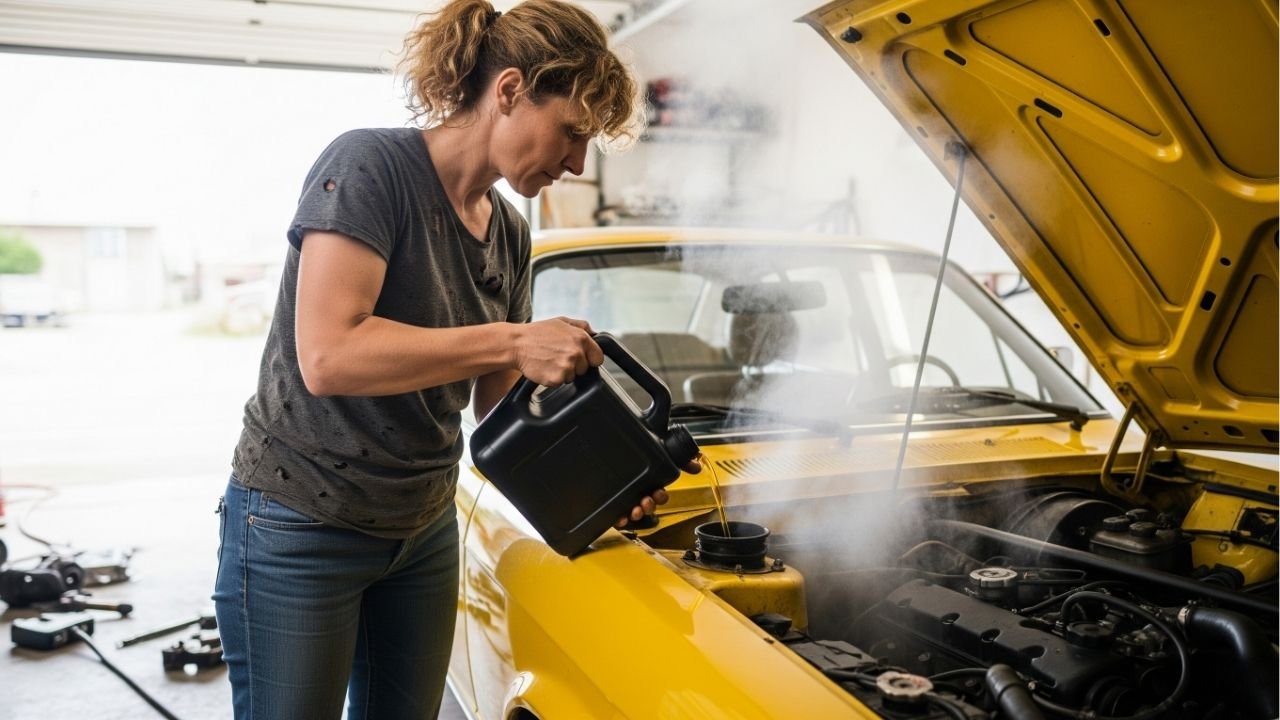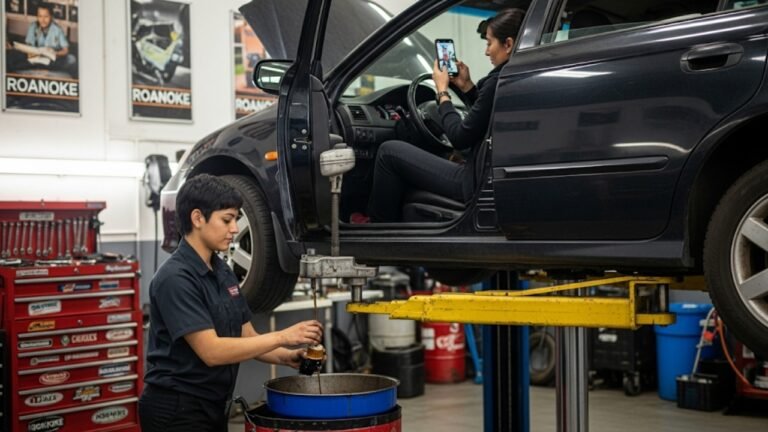Can I Put Oil in a Hot Car?

A few summers ago, right in the middle of Dhaka’s unbearable heatwave, I popped the hood of my car to check the oil. Steam hissed from under the engine bay, my T-shirt stuck to my back, and the only thing on my mind was: “Can I put oil in a hot car?”
Sounds familiar? Maybe you’ve had a similar experience—late for work, engine sizzling, and the oil dipstick screaming “low!”
That question might seem simple, but the answer is more nuanced than most people realize. Putting oil in a hot engine isn’t always dangerous, but it’s not always smart either. The timing, the temperature, and the method all matter.
In this guide, I’ll break down everything you need to know. We’ll explore when it’s okay, when it’s risky, and how to safely top off your oil even if your car feels like a frying pan.
Understanding Engine Heat: Why the Temperature Matters

Now, let’s get something straight:
Yes, you technically can put oil in a hot car. But should you? That’s the key.
When oil is poured into a very hot engine, especially if the car just turned off after a long drive, here’s what can happen:
-
The oil can flash boil if it hits superheated metal.
-
There’s a risk of burn injuries if you’re not careful.
-
Oil might not drain evenly into the pan, giving you a false reading.
-
You could end up overfilling—which causes problems too.
Just because your engine is hot doesn’t mean disaster will strike when adding oil—but like pouring cold water into a boiling pot, you need caution and common sense.
How Hot is “Too Hot” for Oil?
Let’s simplify with a quick temperature comparison in this table:
| Engine State | Temperature (°F) | Is It Safe to Add Oil? |
|---|---|---|
| Cold/Room Temp | ~70°F – 100°F | Very Safe |
| Warm (idled for a few mins) | ~120°F – 150°F | Safe with caution |
| Just Turned Off After Drive | ~190°F – 220°F | Risky, wait 15–30 mins |
| Overheated Engine | 230°F+ | Dangerous, cool down first |
So, the magic number is around 190°F and above. That’s the range where you want to wait a bit before pouring oil. If the car just came off the highway, go grab a chai and give it a 20-minute breather.
Why Some Mechanics Still Add Oil When Hot
If you’ve ever watched a seasoned car mechanic top up oil without flinching, don’t get confused. They’re usually:
-
Wearing gloves and using tools.
-
Working on engines that are warm, not blazing hot.
-
Experienced enough to avoid spilling on hot engine parts like the manifold.
They also know the flow behavior of oil well—hot oil flows faster and more evenly than cold oil. This helps it reach nooks and crannies quicker. But again, they know when the heat is manageable.
So yes, oil can go in while warm, but the real rule is: Avoid pouring oil when the engine is dangerously hot.
Real-World Story: My Brother’s Burnt Fingers
Let me share a quick story. My younger brother, fresh out of college and eager to “learn cars,” saw that his Civic was low on oil after a trip. He turned the car off and immediately opened the cap. Guess what?
Steam shot out. He got a minor burn on his wrist.
He also spilled oil on the engine block. The smell? Horrendous. It smoked like a street-side grill for 15 minutes.
Moral of the story? Wait.
Even if you’re in a rush, give your engine 15–20 minutes to calm down. Trust me—it’s better than smelling burnt oil for days or nursing blisters.
Safe Steps: How to Add Oil When the Engine is Warm
Here’s a quick step-by-step guide to safely add oil to a warm (not hot) engine:
-
Step 1: Park on level ground
A tilted car gives you false oil readings. -
Step 2: Turn off the engine and wait 15-30 minutes
Let the oil settle and engine parts cool down. -
Step 3: Open the hood carefully
Touch the hood gently to test the heat first. -
Step 4: Wipe the dipstick and check oil level
If it’s low, go ahead with a small top-off. -
Step 5: Pour slowly using a funnel
No funnel? Fold a clean plastic bottle or paper into a cone. -
Step 6: Check again
Don’t overfill. Half a quart at a time is a safe bet.
Being methodical here saves time and headache. And remember: a little oil goes a long way.
Risks of Adding Oil to a Very Hot Car
Now let’s talk about why people warn you against it. Here are some real dangers:
1. Flash Boil or Evaporation
If you pour cold oil into a sizzling engine, it may “flash” boil—or quickly vaporize on contact with scorching metal. That’s not just wasteful, it also risks a steam burst.
2. False Dipstick Reading
Hot oil is thinner and may settle differently. If you pour too fast, you may think it’s still low—and keep adding. That’s how overfilling happens.
3. Burn Injuries
Oil caps, dipsticks, and even nearby components can burn your hand if you rush. Gloves help, but waiting helps more.
4. Smoke or Fire Hazard
Oil spilled onto exhaust components can catch fire in extreme cases. More often, it just smokes like crazy and smells awful.
So again, yes—you can put oil in a hot car, but the better question is: Should you risk it?
The Best Time to Check and Add Oil
Here’s a golden tip: Check your oil early in the morning. That’s when:
-
The engine is cold and settled.
-
You’ll get an accurate dipstick reading.
-
You’re more likely to notice leaks or low levels before you drive.
And if you ever need to top up mid-drive? Just pull over, wait 20 minutes, and proceed with caution. Safety first.
Common Myths About Adding Oil to a Hot Engine
Let’s bust some myths that float around garages and WhatsApp groups like half-baked advice.
Myth 1: “Hot oil will burn the engine if you add more.”
Nope. Engines are designed to handle oil at high temperatures. Adding oil won’t harm the engine itself, unless you’re pouring it into a dangerously overheated system—then you’ve got bigger problems.
Myth 2: “Cold oil will crack the engine block.”
False again. Your engine doesn’t crack just because of cold oil. What causes cracks is thermal shock—when extreme cold (think ice water) hits extremely hot metal instantly. That won’t happen with oil at room temperature.
Myth 3: “You should only add oil when the engine is stone-cold.”
That’s overly cautious. Warm is okay—and sometimes better—because warm oil flows smoothly. The key is knowing the difference between warm and scorching.
How Overfilling Oil Happens in Hot Cars
Here’s the tricky part many people forget: hot oil expands.
If your car just ran a long distance and you check the dipstick while the oil is hot, it may show slightly higher than normal levels. If you add oil based on that reading, you might end up overfilling.
And that causes a world of problems:
-
Foamy oil (from crankshaft churning it like butter).
-
Poor lubrication.
-
Smoke from the tailpipe.
-
Possible oil leaks and damaged seals.
So here’s a golden rule:
Always wait before measuring. You need a calm engine for a clear picture.
Personal Tip: A Cheap Funnel Saves Your Engine
Here’s a little life hack. I keep a plastic funnel in my trunk, tucked behind the spare tire. Bought it from a roadside hardware shop for 30 taka (less than 50 cents). That cheap funnel saved me from spilling oil on the engine countless times.
Especially in older cars, where the oil fill opening is surrounded by wires and hot parts, that funnel creates distance and precision.
Even if you don’t drive a lot, stash a small kit:
-
Funnel
-
Latex gloves
-
Rag or tissue
-
A quart of engine oil (the correct one)
-
Headlamp or flashlight
Trust me, you’ll thank yourself someday.
What Happens If You Add Oil Too Soon?
Say you don’t wait and pour oil immediately after turning the engine off. What’s the worst that can happen?
Here’s what might go wrong:
-
Oil splashes back due to heat.
-
Dipstick readings lie, tempting you to add more.
-
You burn yourself on a hot manifold or valve cover.
-
Oil may partially vaporize or thin out before it settles.
While your engine won’t explode, the results could be messy, inaccurate, or just plain frustrating.
Your best bet? Take a break. Let the engine cool. Listen to a podcast. Call your mom. Then come back with peace of mind.
Signs That You Need to Add Oil (Hot or Cold)
Not sure if you should even be adding oil? Look out for these signs:
| Symptom | What It Means |
|---|---|
| Oil warning light on dash | Critical low oil – top up ASAP! |
| Knocking or ticking sounds | Low oil pressure or lubrication failure |
| Burning oil smell | Possible oil leak or overheat |
| Dipstick below “MIN” mark | Add oil immediately (when safe to do so) |
If you spot any of these during a drive, stop the car, wait a bit, and then top off—carefully.
Best Practices for Topping Off in a Hot Car Emergency
If you’re stranded or in an urgent situation where you absolutely must add oil when the car’s hot, follow this protocol:
-
Pull over safely and turn off the engine.
-
Pop the hood and let the heat dissipate for at least 10–15 minutes.
-
Use gloves or cloth to avoid burns.
-
Check the oil level slowly. If it’s below safe levels, add a little at a time—usually half a quart.
-
After adding, wait another 5 minutes and check again.
Only do this if there’s no other choice. And once you’re back home, check again in the morning and adjust if needed.
The Long-Term Risks of Poor Oil Habits
Bad oil habits don’t just cause momentary problems—they slowly kill your engine.
Here’s what long-term abuse can do:
-
Shorten engine life.
-
Cause piston wear and cylinder scoring.
-
Lead to oil sludge buildup.
-
Decrease fuel efficiency.
-
Trigger check engine lights constantly.
This isn’t just theory. Mechanics across Bangladesh, India, the US—everywhere—report the same thing:
Neglecting your oil routine is like skipping water for your body. Eventually, you’ll overheat and shut down.
FAQs About Putting Oil in a Hot Car
1. Can I put oil in a hot car engine immediately after driving?
No, it’s not recommended. Wait 15–30 minutes after turning off the engine. This allows oil to settle and engine parts to cool, making it safer and more accurate.
2. What if the oil warning light comes on during a drive?
Pull over as soon as it’s safe. Turn off the engine, wait 10–15 minutes, then check the oil. Add oil only if it’s low—and do so cautiously.
3. Will cold oil damage a hot engine?
Not directly, but it can vaporize quickly or cause sudden thermal imbalance. It’s always better to let the engine cool a bit before adding room-temperature oil.
4. Can I check my oil level when the engine is hot?
You can, but results may be misleading. Oil expands when hot, so your dipstick might show higher than actual. Wait for a more accurate reading.
5. What kind of oil should I carry in my car?
Always carry the oil that matches your car’s manual-specified grade—like 5W-30 or 10W-40. Synthetic is more stable at high temps, but check your manual first.
6. Is overfilling oil worse than underfilling?
Yes! Overfilled oil causes foaming, poor lubrication, and engine strain. If you must choose in a pinch, being slightly low is safer than overfull—just don’t drive too far like that.
7. How do I know if I’ve added too much oil?
Look for white smoke, sluggish performance, or a high dipstick reading. If you see bubbles on the dipstick, it’s likely overfilled. In that case, drain the excess immediately.
8. Does putting oil in a hot car void the warranty?
Not usually—but any engine damage from poor oil maintenance might. Always follow your manufacturer’s oil check/add intervals and use the correct oil type.
Final Thoughts: Wait, Watch, and Then Pour
So, back to that big question: Can I put oil in a hot car?
Yes—but carefully and wisely. It’s not a death sentence for your engine, but it does come with risks. The best advice? Wait for the engine to cool slightly, pour slowly, and don’t overdo it.
Think of it like this:
Would you water your plants with boiling tea? No. Then why pour oil into a boiling engine?
With a little patience, some planning, and a good funnel, you’ll keep your engine happy—and your hands burn-free.






